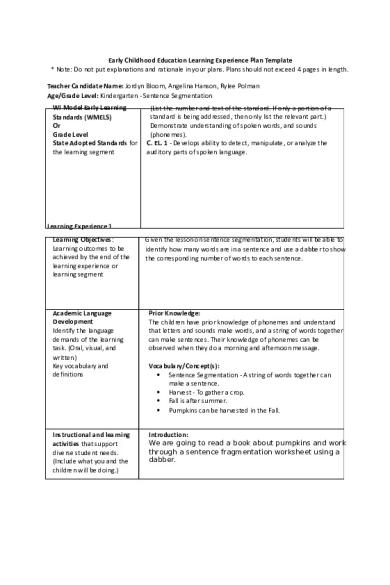edTPA Literacy Lesson (K) - Sentence Segmentation PDF

| Title | edTPA Literacy Lesson (K) - Sentence Segmentation |
|---|---|
| Course | Primary Education |
| Institution | University of Wisconsin-Stout |
| Pages | 3 |
| File Size | 112.7 KB |
| File Type | |
| Total Downloads | 107 |
| Total Views | 142 |
Summary
ECE-305 - Lindsay Barnhart - UW-Stout
Kindergarten Literacy Lesson on Sentence Segmentation...
Description
Early Childhood Education Learning Experience Plan Template * Note: Do not put explanations and rationale in your plans. Plans should not exceed 4 pages in length. Teacher Candidate Name: Jordyn Bloom, Angelina Hanson, Rylee Polman Age/Grade Level: Kindergarten - Sentence Segmentation WI Model Early Learning Standards (WMELS) Or Grade Level State Adopted Standards for the learning segment
(List the number and text of the standard. If only a portion of a standard is being addressed, then only list the relevant part.) Demonstrate understanding of spoken words, and sounds (phonemes). C. EL. 1 - Develops ability to detect, manipulate, or analyze the auditory parts of spoken language.
Learning Experience 1 Learning Objectives: Learning outcomes to be achieved by the end of the learning experience or learning segment
Given the lesson on sentence segmentation, students will be able to identify how many words are in a sentence and use a dabber to show the corresponding number of words to each sentence.
Academic Language Development Identify the language demands of the learning task. (Oral, visual, and written) Key vocabulary and definitions
Prior Knowledge: The children have prior knowledge of phonemes and understand that letters and sounds make words, and a string of words together can make sentences. Their knowledge of phonemes can be observed when they do a morning and afternoon message.
Instructional and learning activities that support diverse student needs. (Include what you and the children will be doing.)
Introduction: We are going to read a book about pumpkins and work through a sentence fragmentation worksheet using a dabber.
Vocabulary/Concept(s): Sentence Segmentation - A string of words together can make a sentence. Harvest - To gather a crop. Fall is after summer. Pumpkins can be harvested in the Fall.
Link to teaching and learning theories and context for learning.
Procedures: 1. Read It’s Pumpkin Time! 2. Explain what sentence fragment means 3. Show an example of how to find the number of words within a sentence. 4. Hand out the worksheets and orange dabbers 5. We will begin our assessment of observation. Closure: “Today we learned about sentence fragmentation and how to count the number of words within a sentence.” Transition: We will sing the Leaves are Falling Down.
Instructional Resources and Materials used to engage children in this learning experience
It’s Pumpkin Time! Book Fall themed sentence segmentation worksheet Orange dabbers Sentence strips for explanation
Informal and/or formal assessments used to monitor children’ learning and feedback provided *Review examples shared in the edTPA handbook glossary
Informal: Observe children as they dab the pumpkins to represent the number of words in the sentence. Formal: Collect the worksheet to make copies and place into student portfolio.
Adaptations of Learning Tasks and Materials (Differentiated instruction) *Review “variety of learners” in the edTPA handbook glossary
Multimodal teaching approaches: For kinesthetic learners, there is a movement piece in the procedure using the dabbers. For auditory learners, we have the story that we are reading. For visual learners, we will have a hands-on worksheet. Individualization: Enrichment: We will give the student sentences that contain more words as they work through the worksheet. Remedial: We will have the number of corresponding pumpkins to each sentence listed on the back. Interdisciplinary Language & Literacy: Students will be reading sentence segmentations. Math: Students will be counting the number of words within each sentence. Art: Students will be using the orange dabbers to color the number
of words in each sentence requiring fine motor skills. Science: Students will be learning about the harvesting of pumpkins and leaves falling from trees in the Fall season. Central Focus
Subject specific content: (language, math, science, social studies) This literacy lesson focuses on language by having the students identify segments of sentences and how the words work together to create one sentence. This lesson also includes science, as we discuss the changing of seasons and the harvesting of crops during fall. Art and Movement are also implemented within this lesson as the students will be exercising their fine motor skills while using the dabber to color the corresponding amount of pumpkins per each sentence....
Similar Free PDFs

Lesson Plan 3- Edtpa
- 4 Pages

Lesson Plans- Edtpa
- 11 Pages

Segmentation
- 2 Pages

Instructional Commentary- Edtpa
- 5 Pages

La segmentation
- 2 Pages

Market Segmentation
- 7 Pages

Conditional Sentence
- 13 Pages

Image Segmentation
- 3 Pages

Computer literacy
- 5 Pages
Popular Institutions
- Tinajero National High School - Annex
- Politeknik Caltex Riau
- Yokohama City University
- SGT University
- University of Al-Qadisiyah
- Divine Word College of Vigan
- Techniek College Rotterdam
- Universidade de Santiago
- Universiti Teknologi MARA Cawangan Johor Kampus Pasir Gudang
- Poltekkes Kemenkes Yogyakarta
- Baguio City National High School
- Colegio san marcos
- preparatoria uno
- Centro de Bachillerato Tecnológico Industrial y de Servicios No. 107
- Dalian Maritime University
- Quang Trung Secondary School
- Colegio Tecnológico en Informática
- Corporación Regional de Educación Superior
- Grupo CEDVA
- Dar Al Uloom University
- Centro de Estudios Preuniversitarios de la Universidad Nacional de Ingeniería
- 上智大学
- Aakash International School, Nuna Majara
- San Felipe Neri Catholic School
- Kang Chiao International School - New Taipei City
- Misamis Occidental National High School
- Institución Educativa Escuela Normal Juan Ladrilleros
- Kolehiyo ng Pantukan
- Batanes State College
- Instituto Continental
- Sekolah Menengah Kejuruan Kesehatan Kaltara (Tarakan)
- Colegio de La Inmaculada Concepcion - Cebu






